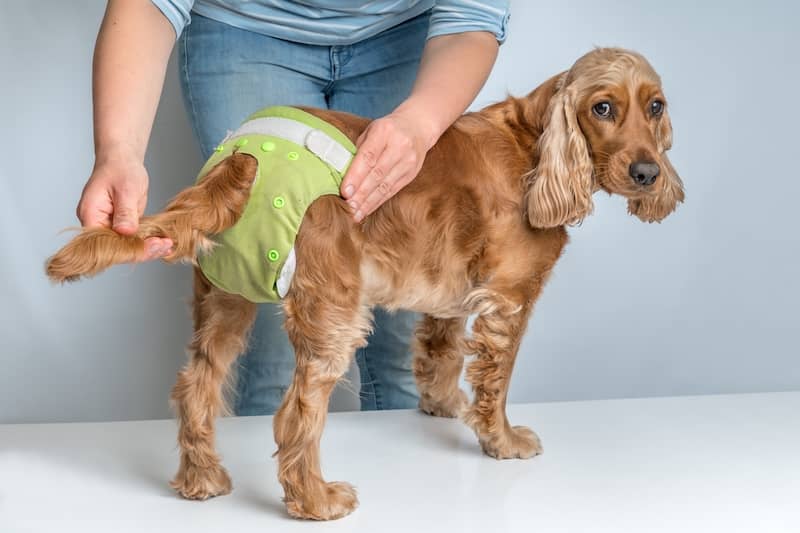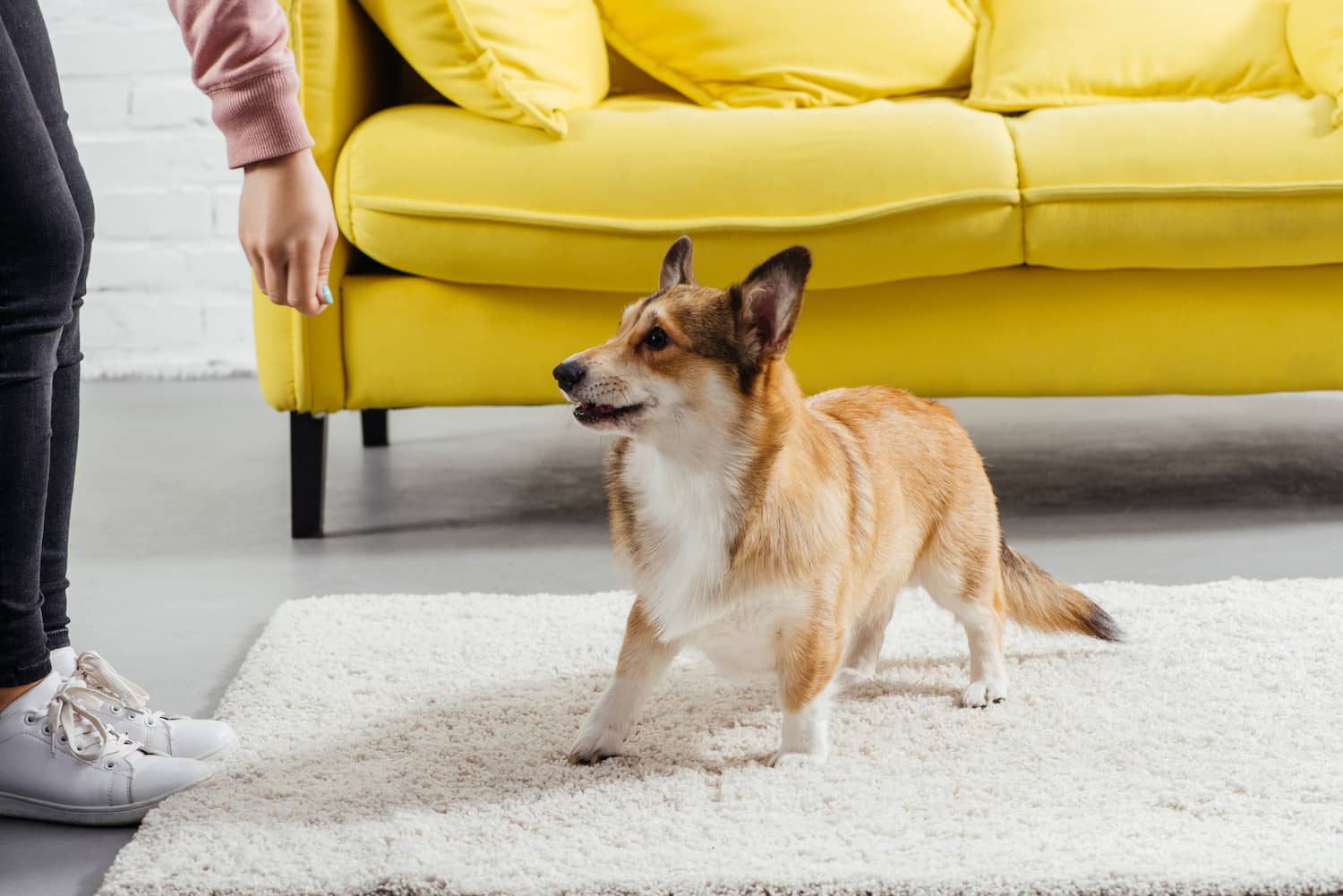A common question we get asked is "How long is a dog in heat?" and you may be asking the same. A dog's heat cycle typically lasts 2-4 weeks. Unspayed females experience this cycle twice a year, approximately every 6 months. Whether you're navigating puppy adolescence or considering breeding, knowing the signs and timeline of your dog's heat can help you provide the right care at the right time. This article will discuss a female dog's heat (estrous) cycle in detail, serving to provide you with a helpful resource.
Typically, a dog's heat cycle lasts about 2-4 weeks.
First Stage (Proestrus): Lasts on average, 9 days. Signs include swelling of the vulva and a bloody discharge.
Second Stage (Estrus): This is the actual mating period, lasting on average, 9 days. The discharge decreases in volume and becomes lighter in color.
Understanding the heat cycle in dogs
The heat cycle, also known as the estrous cycle, is part of a female dog's reproductive system. This is the period where she becomes receptive to mating and potentially getting pregnant. This cycle is comprised of four distinct stages, each with its unique characteristics and duration.
1. Proestrus
The start of your dog's heat cycle, or proestrus, is usually marked by two key signs: her vulva may look swollen and you might notice a bloody discharge, which is actually coming from her uterus. The first day you see this bleeding is often referred to as the first day of heat. The bleeding can vary in amount from dog to dog and sometimes it might even go unnoticed. The time between the start of proestrus and when your dog is ready to mate can range anywhere from just 1 day to up to 21 days.
During this proestrus stage, you might see male dogs showing interest in your female dog, but she's not ready to mate with them yet. This period is a time of increasing levels of a hormone called estrogen, which gets her body ready for breeding. This estrogen is produced in parts of her ovaries called follicles. There's also a rise in a hormone called testosterone during this time. Another hormone, progesterone, stays low during proestrus, but begins to increase just before the next stage, estrus, when she will be ready to mate.
2. Estrus
The estrus stage is usually recognized as the time when your dog is ready and willing to mate as this is the stage where a female dog accepts a male for breeding. Hormonally, the estrus phase in dogs begins on the day of the luteinizing hormone (LH) surge followed by rapidly rising progesterone levels. Estrus is also characterized by decreasing estrogen levels.
About 2 days after the surge in the luteinizing hormone (LH), your dog usually ovulates, which means she releases eggs to be fertilized. After the eggs are released, structures known as corpora lutea are formed. Under the influence of LH, these structures start to produce the hormone progesterone. This is why vets often suggest breeding your dog about 1-2 days after her progesterone levels go above 5 ng/ml.
During this time, you'll notice that her discharge changes from a bloody color to a lighter, straw-like color. She will also allow a male dog to mount her. The swelling in the vulva will start to go down slightly and become less firm.
The estrus heat stage lasts 5-14 days (average of 9 days), marking the period when the dog is ready and willing to mate. There are hormonal changes, with the dog typically ovulating 2 days after a surge in the luteinizing hormone (LH). The discharge changes from bloody to straw-like, and the dog is receptive to a male dog.
3. Diestrus
Diestrus is the next stage after estrus. This stage signals the end of your dog's fertile period, meaning she is no longer fertile and will not accept a male. It usually starts around 7 to 9 days after the estrus period but can vary between dogs. Vulvar discharge and swelling decrease during the diestrus phase.
In non-pregnant dogs, progesterone levels increase during diestrus and then go back to a normal level (which takes about 3 months). The diestrus period ends either when the female dog gives birth (which happens 65 days after the LH surge in estrus) or when the progesterone level returns to normal.
4. Anestrus
Following the diestrus stage, your dog enters a calm period known as the anestrus stage. Think of it as a well-deserved break for your furry friend's body - especially her uterus. This downtime allows her body to recharge and prepare for the next heat cycle. Anestrus typically lasts around four months but in some cases, it can stretch out to a whole year or so.
During this resting stage, your dog's progesterone levels take a dip. Her estrogen levels are also on the lower side but start to pick up again as she nears the end of the anestrus stage. Another hormone, prolactin, also decreases during this time. So, anestrus is really a time for your dog's body to rest and reset before she embarks on the next heat cycle.

How long is a dog in heat?
On average, a dog is in heat for 9 days but can range from 2 days to 4 weeks. This refers to the time in which she will accept a male for mating.
A female dog usually experiences her first heat cycle around the age of 5 to 12 months, although it can vary between breeds. Each stage of the estrous cycle has its own unique duration and characteristics.
The proestrus stage typically lasts for 7 to 10 days, while the estrus phase ranges from 5 to 14 days. This is followed by diestrus, which usually lasts for 60 to 90 days. Finally, the anestrus phase can last anywhere from 4 months to a year.
The first day of bleeding in proestrus is the first day of heat. Bleeding will last for 7-9 days or so but can vary between dogs. After the bleeding stops, the dog enters the estrus phase where she will be fertile and accept a male. The average length of estrus in dogs is 9 days but can vary between 5-21 days. Therefore, a dog will be in heat for an average of 2 to 3 weeks.
Female dogs release immature (primary) oocytes during ovulation, unlike most mammals. These primary oocytes need to undergo a first division to become secondary oocytes, which can then be fertilized. The process of becoming secondary oocytes usually takes 48-72 hours after ovulation. After that, they remain capable of being fertilized for around 2-5 days.
What are the signs of a dog being in heat?
Here are some signs you might notice when your dog goes into heat:
Swelling of the Vulva: This is often the first noticeable sign. Your dog's private area might look swollen or enlarged.
Bloody Discharge: You might notice a bloody discharge from your dog. This can range from bright red to a more muted brown color. It usually starts off quite heavy and then becomes lighter, often turning a straw color as she moves into the most fertile part of her cycle.

Increased Urination: Your dog might urinate more frequently than usual. This is her way of leaving "scent messages" for male dogs to pick up on.
Behavior Changes: You may notice changes in your dog's behavior. She might become more affectionate or clingy, or alternatively, she might seem a bit agitated or restless.
Flirting: When she's in the most fertile part of her heat cycle, you might see your dog "flirting" with male dogs. She might lift her tail to the side (this is known as "flagging"), or she could show other inviting behaviors towards male dogs.
Male Dogs Are More Interested in Her: Male dogs are very good at picking up the scent of a female dog in heat, even from a distance. If you notice male dogs are showing an increased interest in your dog, she could be in heat.
Caring for a dog in heat
- Keep Her Indoors: Throughout the heat cycle, female dogs may exhibit heightened attractiveness to male counterparts, leading to persistent approaches. To ensure the utmost safety and prevent unintended pregnancies, it is recommended to confine your dog indoors as much as possible, especially during the estrus phase when she experiences peak fertility.
- Use Doggie Diapers: You might notice some blood spots around your home when your dog is in heat. Doggie diapers or special absorbent pads can help manage this. They're available in pet stores and online.
- Maintain Regular Exercise: Even though you're keeping her indoors, she'll still need her regular exercise. Try to engage her in indoor activities that can keep her active and distracted.
- Monitor Her Behaviour: Her behavior may change during her heat cycle, such as becoming more affectionate or restless. Pay attention to her behavior and provide comfort when needed.
- Comfort is Key: You may notice your dog is more sensitive or uncomfortable than usual. Providing her with a comfortable and quiet space can help her feel more at ease.
- Nutrition and Hydration: Make sure she's eating well and staying hydrated. Some dogs may have a change in appetite during their heat cycle.
- Professional Help: In the event of noticeable and pronounced changes in behavior or health, such as excessive bleeding, lethargy, or loss of appetite, it is highly recommended to consult with your veterinarian for expert guidance and assistance.
FAQs about the heat cycle in dogs
How long does a dog in heat bleed?
Typically, a dog in heat will bleed for 7-10 days. However, this can vary between dogs and should always be monitored closely.
How long does a dog stay in heat?
The entire heat cycle for a female dog typically lasts between 2-4 weeks. The proestrus stage is usually 7-10 days, the estrus phase 5-14 days, diestrus 60-90 days, and anestrus 4 months to a year.
How often do female dogs go into heat?
Female dogs typically go into heat twice a year but some breeds may cycle every 6 months. This is something that you should discuss with your veterinarian to ensure the best care for your pet.
In conclusion, a dog's heat cycle is a natural process that comes with several noticeable signs, including a swollen vulva, increased urination, behavior changes, and increased attention from male dogs. The cycle, comprising of proestrus, estrus, diestrus, and anestrus stages, lasts about six months but can vary depending on the breed and overall health of the dog. While your dog is in heat, it's crucial to keep a close eye on her, provide comfort, manage any behavioral changes, and keep her indoors to prevent unplanned pregnancies. If you notice any extreme behavior or health changes, don't hesitate to reach out to your veterinarian. Remember, patience and understanding are key during this time. Your dog relies on you to help her navigate this part of her life comfortably and safely. If you have any questions about the heat cycle in your dog, please contact your veterinarian.


